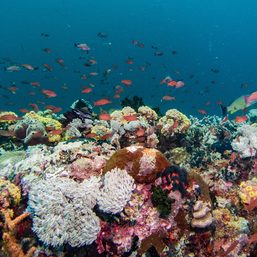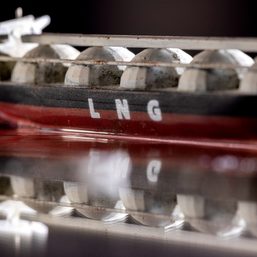SUMMARY
This is AI generated summarization, which may have errors. For context, always refer to the full article.
Janet Napoles is summoned twice to appear in a Senate probe in connection with the 2004 fertilizer scam but the political tempest then distracts the Senate from digging deeper
 MANILA, Philippines – Those who do not learn from the past are bound to repeat it. Or more precisely, those who got away in the past will try to repeat it. Such is the story of the Malampaya Fund scam which is poised to put to shame its predecessor, the P728-million fertilizer fund scandal.
On Thursday, October 3, the Department of Justice will be filing criminal charges in connection with the Malampaya Fund scam. Justice Secretary Leila de Lima is expected to file the case before the Office of the Ombudsman.
Commission on Audit Chair Grace Pulido Tan earlier described the case as “explosive.”
READ: How the Malampaya fund was plundered
It is a scam whose back story is more riveting than that of the 2004 fertilizer fund scam, more brazen in terms of how easily a bunch of people almost managed to pull it off.
In the fertilizer fund scam, there were a number of characters who supposedly benefited from the irregularity through kickbacks in fertilizers that were found to be overpriced but substandard. From lawmakers, local officials to dubious suppliers, they partook of the largesse from the Department of Agriculture, shortchanging the farmers who were supposed to be the final beneficiaries.
In the Malampaya Fund scam, only a few people shared the money, with the bulk going to Janet Lim Napoles, the woman also at the center of the pork barrel scam.
READ: ‘Madame Jenny:’ Woman in the eye of a storm
This time around, it was the local government units that were hoodwinked, with signatures of LGU officials forged by Napoles’ team which had mastered the art of counterfeiting.
Adding insult to injury, not a single agricultural equipment or support was downloaded to the farmers, who were at the time still recovering from the onslaught of typhoons Ondoy and Pepeng.
Premeditated
The Malampaya Fund represents royalties from the oil and gas operations in the waters off Palawan. In October 2009, President Gloria Macapagal-Arroyo issued an executive order expanding the use of the fund for other purposes, apart from energy-related projects. A total of P900 million was taken from the Malampaya Fund to assist farmers affected by natural calamities that year.
To go by the accounts of whistleblowers and the internal probe of the Department of Agrarian Reform, it was a premeditated crime, aided by the keen ability of Napoles to sniff out funds.
One of the purported whistleblowers, Merlina Suñas, in an affidavit submitted to the National Bureau of Investigation, said Napoles informed her staff that she was able to get hold of some funding from the DAR as early as July or August that year. This was a month or so before the government set aside the P900 million from the Malampaya Fund to help farmers affected by typhoons.
In October 2009, Napoles again met her staff with instructions to prepare the documents they would need for the DAR funding. These include forged letter requests from LGUs, MOAs and project proposals.
The next step was to determine which of the NGOs they had earlier set up would be used for the Malampaya Fund. An internal probe of the DAR showed the NGOs were just waiting in the wings, ready to be tapped at the right time.
Of the 12 non-governmental organizations that cornered the P900-million funds, 4 were registered with the Securities and Exchange Commission (SEC) in July 2009, or 3 months before an agreement was reached to tap the funds to help agricultural rural communities.
Five NGOs on the other hand, were registered with the SEC in April 2008; two in November 2008, and one in July 2004.
These 12 NGOs supposedly entered into an agreement with 97 LGUs to serve as either fund conduits or NGO cooperators in the implementation of projects amounting to between P7.5 million to P10 million. All of these 12 NGOs, per accounts of whistleblowers, were all under Napoles’ control.
Principal whistleblower Benhur Luy earlier told a Senate hearing that he and other employees of Napoles were instructed by her to put up a number of NGOs and foundations. Based on the COA report for the period 2007-2009, some of these NGOs were tapped to siphon the pork barrel funds of lawmakers.
The other NGOs apparently came in handy when the P900-mllion Malampaya Fund came out.
Based on an earlier Rappler report, Napoles got first crack at the Malampaya Fund based on advance information provided by a department secretary. Indications show the grant of funds to NGOs linked to her was pre-arranged with the complicity of DAR officials.
P587.5 million released in 2 days
Based on the internal probe of the DAR, the sham that is the Malampaya Fund defied usual accounting procedures:
MANILA, Philippines – Those who do not learn from the past are bound to repeat it. Or more precisely, those who got away in the past will try to repeat it. Such is the story of the Malampaya Fund scam which is poised to put to shame its predecessor, the P728-million fertilizer fund scandal.
On Thursday, October 3, the Department of Justice will be filing criminal charges in connection with the Malampaya Fund scam. Justice Secretary Leila de Lima is expected to file the case before the Office of the Ombudsman.
Commission on Audit Chair Grace Pulido Tan earlier described the case as “explosive.”
READ: How the Malampaya fund was plundered
It is a scam whose back story is more riveting than that of the 2004 fertilizer fund scam, more brazen in terms of how easily a bunch of people almost managed to pull it off.
In the fertilizer fund scam, there were a number of characters who supposedly benefited from the irregularity through kickbacks in fertilizers that were found to be overpriced but substandard. From lawmakers, local officials to dubious suppliers, they partook of the largesse from the Department of Agriculture, shortchanging the farmers who were supposed to be the final beneficiaries.
In the Malampaya Fund scam, only a few people shared the money, with the bulk going to Janet Lim Napoles, the woman also at the center of the pork barrel scam.
READ: ‘Madame Jenny:’ Woman in the eye of a storm
This time around, it was the local government units that were hoodwinked, with signatures of LGU officials forged by Napoles’ team which had mastered the art of counterfeiting.
Adding insult to injury, not a single agricultural equipment or support was downloaded to the farmers, who were at the time still recovering from the onslaught of typhoons Ondoy and Pepeng.
Premeditated
The Malampaya Fund represents royalties from the oil and gas operations in the waters off Palawan. In October 2009, President Gloria Macapagal-Arroyo issued an executive order expanding the use of the fund for other purposes, apart from energy-related projects. A total of P900 million was taken from the Malampaya Fund to assist farmers affected by natural calamities that year.
To go by the accounts of whistleblowers and the internal probe of the Department of Agrarian Reform, it was a premeditated crime, aided by the keen ability of Napoles to sniff out funds.
One of the purported whistleblowers, Merlina Suñas, in an affidavit submitted to the National Bureau of Investigation, said Napoles informed her staff that she was able to get hold of some funding from the DAR as early as July or August that year. This was a month or so before the government set aside the P900 million from the Malampaya Fund to help farmers affected by typhoons.
In October 2009, Napoles again met her staff with instructions to prepare the documents they would need for the DAR funding. These include forged letter requests from LGUs, MOAs and project proposals.
The next step was to determine which of the NGOs they had earlier set up would be used for the Malampaya Fund. An internal probe of the DAR showed the NGOs were just waiting in the wings, ready to be tapped at the right time.
Of the 12 non-governmental organizations that cornered the P900-million funds, 4 were registered with the Securities and Exchange Commission (SEC) in July 2009, or 3 months before an agreement was reached to tap the funds to help agricultural rural communities.
Five NGOs on the other hand, were registered with the SEC in April 2008; two in November 2008, and one in July 2004.
These 12 NGOs supposedly entered into an agreement with 97 LGUs to serve as either fund conduits or NGO cooperators in the implementation of projects amounting to between P7.5 million to P10 million. All of these 12 NGOs, per accounts of whistleblowers, were all under Napoles’ control.
Principal whistleblower Benhur Luy earlier told a Senate hearing that he and other employees of Napoles were instructed by her to put up a number of NGOs and foundations. Based on the COA report for the period 2007-2009, some of these NGOs were tapped to siphon the pork barrel funds of lawmakers.
The other NGOs apparently came in handy when the P900-mllion Malampaya Fund came out.
Based on an earlier Rappler report, Napoles got first crack at the Malampaya Fund based on advance information provided by a department secretary. Indications show the grant of funds to NGOs linked to her was pre-arranged with the complicity of DAR officials.
P587.5 million released in 2 days
Based on the internal probe of the DAR, the sham that is the Malampaya Fund defied usual accounting procedures:
- Even before the Department of Budget and Management (DBM) issued the Special Allotment Release Order indicating that P900 million has been allotted to DAR, former DAR Undersecretary for Administration and Finance Narciso Nieto entered into MOAs with 12 NGOs appropriating these with P7.5 million to P10 million funding per LGU.
- A total of 33 checks amounting to P312.million were issued to the NGOs as payment for the projects weeks before the Notice of Cash Allotment was issued by DBM.
- In a matter of 2 days only — December 22 and 23 — 64 checks amounting to P587.5 million were released by DAR to the NGOs.
- Unlike in the pork barrel scam where funding was released in tranches, the total amount of the project was released to the NGOs in one lump sum. This violates COA regulation and procurement laws that say funding should be released in tranches, with the implementing agency or unit first submitting reports on the implementation and liquidation of the initial amounts given — before additional releases are made.
- Checks issued by DAR that were supposed to have been returned by banks could not be located.
Add a comment
How does this make you feel?
Loading





There are no comments yet. Add your comment to start the conversation.